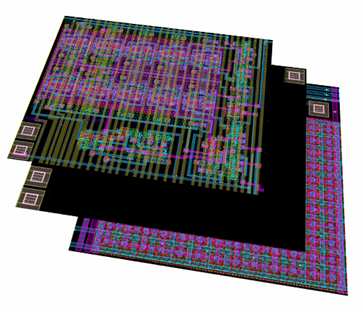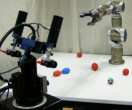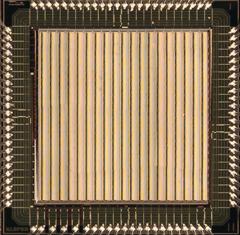 pNeuron
(Printed Electronics for Neuromorphic Computing). In
this project, funded by the EPSRC Centre for
Inoovative Manufacturing in Large-Area Electronics, under the
Pathfinder scheme,
we investigated the implementation of spiking neuron circuits,
mimicking biological behaviour, using printed electronics technology.
Furter details about the project can be found here.
pNeuron
(Printed Electronics for Neuromorphic Computing). In
this project, funded by the EPSRC Centre for
Inoovative Manufacturing in Large-Area Electronics, under the
Pathfinder scheme,
we investigated the implementation of spiking neuron circuits,
mimicking biological behaviour, using printed electronics technology.
Furter details about the project can be found here.
|
 FINE3D
(Fine-Grain Processor Arrays in 3D Silicon Technologies). In this
project, funded by the EPSRC, we investigated the design of
cellular processor arrays for next-generation silicon technologies,
where many device layers can be integrated in a single device. Wafer
stacking and massive interconnect achieved using through-silicon-vias
provides both opportunities and design challenges. We researched
processor architectures that make best use of the available intra-layer
bandwidth, investigated partitioning of the processing circuitry
amongst silicon layers, and looked into heterogenous architectures
where different layers are fabricated using different technologies,
most suitable for individual system components. In particular, we are
interested in fine-grain processor arrays, which we believe provide
architectural solution that can fully exploit the benefits offered by
the 3D integration.
FINE3D
(Fine-Grain Processor Arrays in 3D Silicon Technologies). In this
project, funded by the EPSRC, we investigated the design of
cellular processor arrays for next-generation silicon technologies,
where many device layers can be integrated in a single device. Wafer
stacking and massive interconnect achieved using through-silicon-vias
provides both opportunities and design challenges. We researched
processor architectures that make best use of the available intra-layer
bandwidth, investigated partitioning of the processing circuitry
amongst silicon layers, and looked into heterogenous architectures
where different layers are fabricated using different technologies,
most suitable for individual system components. In particular, we are
interested in fine-grain processor arrays, which we believe provide
architectural solution that can fully exploit the benefits offered by
the 3D integration.
|
 REVERB
(Reverse Engineering
the Vertebrate Brain). This
project was a multidisciplinary collaboration between a number of
universities (Manchester, Sheffield, Aberystwyth, Bristol, Dundee)
investigating integrative computation for autonomous agents, based on
action-selection architecture of the basal ganglia. We were
implementing low-level image processing required for this project, as
well as some neural models, using SCAMP-3 and SCAMP-4 chips. We were
also working towards an FPGA-based accelerator for neural computation,
to tackle the real-time embedded implementation on an autonomous robot.
We developed the APRON
(Array Programming Environment) software, as a front-end to
the accelerator. The software is also an efficient simulation tool on
its own, furthermore it provides a basis for platform-independent array
processor interface, programming language, and code compiler, and has
been adopted to work with SCAMP and ASPA chips. See REVERB project webpage
for details.
REVERB
(Reverse Engineering
the Vertebrate Brain). This
project was a multidisciplinary collaboration between a number of
universities (Manchester, Sheffield, Aberystwyth, Bristol, Dundee)
investigating integrative computation for autonomous agents, based on
action-selection architecture of the basal ganglia. We were
implementing low-level image processing required for this project, as
well as some neural models, using SCAMP-3 and SCAMP-4 chips. We were
also working towards an FPGA-based accelerator for neural computation,
to tackle the real-time embedded implementation on an autonomous robot.
We developed the APRON
(Array Programming Environment) software, as a front-end to
the accelerator. The software is also an efficient simulation tool on
its own, furthermore it provides a basis for platform-independent array
processor interface, programming language, and code compiler, and has
been adopted to work with SCAMP and ASPA chips. See REVERB project webpage
for details.
|
 COLAMN
(Computing Architecture Based on Laminar Microcircuitry of the
Neocortex).
This project was a collaboration between neurobiologists, computational
neuroscientists and VLSI engineers (Manchester, Plymouth, Cambridge,
Oxford) aiming at understanding the way cortical circuits process
information, and ultimately providing ideas for building brain-inspired
microelectronic circuits. We have developed an analogue silicon neuron,
which efficiently implements biologically plausible spiking behaviour
of cortical neurons. Currently we are investigating higher-level
cognitive models of the cortex, and their VLSI implementation. more...
COLAMN
(Computing Architecture Based on Laminar Microcircuitry of the
Neocortex).
This project was a collaboration between neurobiologists, computational
neuroscientists and VLSI engineers (Manchester, Plymouth, Cambridge,
Oxford) aiming at understanding the way cortical circuits process
information, and ultimately providing ideas for building brain-inspired
microelectronic circuits. We have developed an analogue silicon neuron,
which efficiently implements biologically plausible spiking behaviour
of cortical neurons. Currently we are investigating higher-level
cognitive models of the cortex, and their VLSI implementation. more...
|
 Cellular Asynchronous Arrays.
This project investigates design of vision chips and
fine-grain
processor arrays based on novel control schemes, where individual
processors are triggered as data is available at their neighbours,
optimising speed and power consumption of the devices. The aim is to
provide image processing engines suitable for both low-level,
pixel-based operations (filtering, feature detection etc.) as well as
more global, object-based algorithms, such as object reconstruction,
skeletonisation, watarshed transform, distance transform etc. The ASPA
chip contains a SIMD processor array, operating in mixed
bit-serial/bit-parallel mode, as well as a wave-propagating network.
The work continues on next generation of the ASPA processor in the
Fine-Grain 3D project. more...
Cellular Asynchronous Arrays.
This project investigates design of vision chips and
fine-grain
processor arrays based on novel control schemes, where individual
processors are triggered as data is available at their neighbours,
optimising speed and power consumption of the devices. The aim is to
provide image processing engines suitable for both low-level,
pixel-based operations (filtering, feature detection etc.) as well as
more global, object-based algorithms, such as object reconstruction,
skeletonisation, watarshed transform, distance transform etc. The ASPA
chip contains a SIMD processor array, operating in mixed
bit-serial/bit-parallel mode, as well as a wave-propagating network.
The work continues on next generation of the ASPA processor in the
Fine-Grain 3D project. more...
|

 FINE3D
(Fine-Grain Processor Arrays in 3D Silicon Technologies). In this
project, funded by the EPSRC, we investigated the design of
cellular processor arrays for next-generation silicon technologies,
where many device layers can be integrated in a single device. Wafer
stacking and massive interconnect achieved using through-silicon-vias
provides both opportunities and design challenges. We researched
processor architectures that make best use of the available intra-layer
bandwidth, investigated partitioning of the processing circuitry
amongst silicon layers, and looked into heterogenous architectures
where different layers are fabricated using different technologies,
most suitable for individual system components. In particular, we are
interested in fine-grain processor arrays, which we believe provide
architectural solution that can fully exploit the benefits offered by
the 3D integration.
FINE3D
(Fine-Grain Processor Arrays in 3D Silicon Technologies). In this
project, funded by the EPSRC, we investigated the design of
cellular processor arrays for next-generation silicon technologies,
where many device layers can be integrated in a single device. Wafer
stacking and massive interconnect achieved using through-silicon-vias
provides both opportunities and design challenges. We researched
processor architectures that make best use of the available intra-layer
bandwidth, investigated partitioning of the processing circuitry
amongst silicon layers, and looked into heterogenous architectures
where different layers are fabricated using different technologies,
most suitable for individual system components. In particular, we are
interested in fine-grain processor arrays, which we believe provide
architectural solution that can fully exploit the benefits offered by
the 3D integration.
 REVERB
(Reverse Engineering
the Vertebrate Brain). This
project was a multidisciplinary collaboration between a number of
universities (Manchester, Sheffield, Aberystwyth, Bristol, Dundee)
investigating integrative computation for autonomous agents, based on
action-selection architecture of the basal ganglia. We were
implementing low-level image processing required for this project, as
well as some neural models, using SCAMP-3 and SCAMP-4 chips. We were
also working towards an FPGA-based accelerator for neural computation,
to tackle the real-time embedded implementation on an autonomous robot.
We developed the
REVERB
(Reverse Engineering
the Vertebrate Brain). This
project was a multidisciplinary collaboration between a number of
universities (Manchester, Sheffield, Aberystwyth, Bristol, Dundee)
investigating integrative computation for autonomous agents, based on
action-selection architecture of the basal ganglia. We were
implementing low-level image processing required for this project, as
well as some neural models, using SCAMP-3 and SCAMP-4 chips. We were
also working towards an FPGA-based accelerator for neural computation,
to tackle the real-time embedded implementation on an autonomous robot.
We developed the  COLAMN
(Computing Architecture Based on Laminar Microcircuitry of the
Neocortex).
This project was a collaboration between neurobiologists, computational
neuroscientists and VLSI engineers (Manchester, Plymouth, Cambridge,
Oxford) aiming at understanding the way cortical circuits process
information, and ultimately providing ideas for building brain-inspired
microelectronic circuits. We have developed an analogue silicon neuron,
which efficiently implements biologically plausible spiking behaviour
of cortical neurons. Currently we are investigating higher-level
cognitive models of the cortex, and their VLSI implementation.
COLAMN
(Computing Architecture Based on Laminar Microcircuitry of the
Neocortex).
This project was a collaboration between neurobiologists, computational
neuroscientists and VLSI engineers (Manchester, Plymouth, Cambridge,
Oxford) aiming at understanding the way cortical circuits process
information, and ultimately providing ideas for building brain-inspired
microelectronic circuits. We have developed an analogue silicon neuron,
which efficiently implements biologically plausible spiking behaviour
of cortical neurons. Currently we are investigating higher-level
cognitive models of the cortex, and their VLSI implementation.  Cellular Asynchronous Arrays.
This project investigates design of vision chips and
fine-grain
processor arrays based on novel control schemes, where individual
processors are triggered as data is available at their neighbours,
optimising speed and power consumption of the devices. The aim is to
provide image processing engines suitable for both low-level,
pixel-based operations (filtering, feature detection etc.) as well as
more global, object-based algorithms, such as object reconstruction,
skeletonisation, watarshed transform, distance transform etc. The ASPA
chip contains a SIMD processor array, operating in mixed
bit-serial/bit-parallel mode, as well as a wave-propagating network.
The work continues on next generation of the ASPA processor in the
Fine-Grain 3D project.
Cellular Asynchronous Arrays.
This project investigates design of vision chips and
fine-grain
processor arrays based on novel control schemes, where individual
processors are triggered as data is available at their neighbours,
optimising speed and power consumption of the devices. The aim is to
provide image processing engines suitable for both low-level,
pixel-based operations (filtering, feature detection etc.) as well as
more global, object-based algorithms, such as object reconstruction,
skeletonisation, watarshed transform, distance transform etc. The ASPA
chip contains a SIMD processor array, operating in mixed
bit-serial/bit-parallel mode, as well as a wave-propagating network.
The work continues on next generation of the ASPA processor in the
Fine-Grain 3D project.